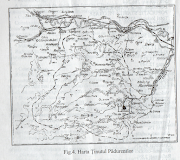MARBLE TOURIST ROUTE - TINUTUL PADURENILOR
Here we are today with a new walk through Tinutul Padurenilor, currently only virtual, in the hope that you will make time to stop in this wonderful land as soon as possible. You will enjoy every moment spent here, where you will meet nice people and you will fill your soul with beauty and a lot of history. Let's travel together today again.
If in the last weeks we travelled on tourist routes, as in the old days, together with the miners from the villages from Tinutul Padurenilor, today we are heading towards the marble road and its surroundings. We have a lot of history behind the story, too.
As we have been accustomed to from the beginning, as every time, we have the starting point from Ghelari, from the Tourist Centre. Following the road to the villages on the tops of hills and mountains, we stop at the Mastacanet Observatory, with the Panorama pension on the left. Regardless of the position you are in, the Observatory, but also nearby the pension, offers you visual images that will take your breath away. The view of the mountains that can be seen in the distance, but also the green colour of nature and the charge of the soul with positive energy.
Heading towards new places, we pass through the village of Ruda, then continue to the Cornet hill, where the famous "Dragan Munteanu" Festival - Foresters Festival takes place. Next is the visit of Poienita Voinii village, the native village of the great rhapsodist Dragan Muntenu, where at the entrance of the village, on the right, on top of a small hill, there is a small wooden church. Right on the main street, near the school, we have the house-museum of the same performer, where we find elements of foresters traditional outfit/costume, but also elements of a traditional house in the area. The locals, regardless of the time, are eager to talk to tourists, taking pride in the stories of the village. Unfortunately, the village is very sparsely populated, with mostly only elderly people.
We are fast approaching the main place of this incursion. From Poienita Voinii on the right side down the road, we take the marble road. The landscape, again, takes the traveller's breath. Arriving at the entrance of the village of Alun, on the left side, we come to the famous marble quarry which has a special history. The People's House in Bucharest, the second largest building in Europe, was also built with marble from this quarry. This marble was also used to make parts of the Ceausescu house, also in Bucharest, but also several churches / cathedrals near the place, Foresters Cathedral, or some from the nearest cities. The 2km marble road, but also the church from the same material are another two important aspects of this village. The marble church is unique in the world, being made only of marble. The architecture of the village, the meeting with the picturesque symbols and the traditions of this village, give a feeling of belonging to the identity of foresters and Romanians. Unfortunately, the locals left for the city life, and only one person lives there. For the rest of the houses, the owners come only on holidays, feeling the need for peace, tired of the hustle and bustle of the city. The wooden church, another tourist attraction in this small forest village, dates back several hundred years, approximately from the 1700s.
Ready for ending the day and this beautiful walk, the tourist loaded with history resumes the road partially paved of marble Alun-Govajdie road to the intersection in Nadrab area, where you can choose Hunedoara way (DC110B) as your final destination, or, climbing to Ghelari road, Ratisoarei valley.
This route, of marble, is a route of medium difficulty and can be a favourable route for bicycles, ATVs, cars, but also on foot. The time to complete the route differs from person to person, but generally it takes 9-10 hours to complete this hike. There are only 24 good kilometers of a day hike through Tinutul Padurenilor.





























0 Comments